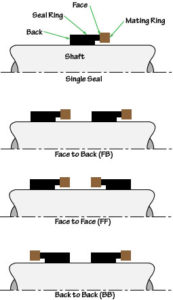Inside-mounted and outside-mounted seals are described as part of SealFAQs “Basics” pages under Classification by Configuration.
The vast majority of all seals fall into the single seal category. Single seals can be mounted inside the process liquid or outside the process liquid.

Inside-mounted seals are sometimes described or even defined as being mounted within the boundaries of the seal chamber. This means that the process fluid is present on the outside diameter of the seal. Inside-mounted seals are easy to cool and are capable of sealing high pressures. The direction of leakage is from the OD to the ID of the seal face; centrifugal force opposes leakage. Inside-mounted seals are by far the most popular.
Outside-mounted seals are sometimes described or defined as being outside the boundaries of the seal chamber. Process fluid is therefore present on the inside diameter of the seal and outside-mounted seals can have minimal contact with the process liquid. The direction of leakage is from the ID to the OD of the seal face; this is the same direction as centrifugal force and outside-mounted seals often leak more than inside-mounted seals.
The concepts of inside-mounted and outside-mounted positions can be and are extended to the outer seal of a dual seal arrangement. That is, the outer seal is either inside-mounted with respect to the containment chamber and buffer/barrier fluid or outside-mounted with respect to the containment chamber and buffer/barrier fluid.
The effects of centrifugal force on leakage are very real but usually small in magnitude and are typically neglected in calculations.
Both inside and outside-mounted can be designed with a balance ratio to keep the faces closed; however, sometimes seals that were really designed to be inside-mounted are simply applied as outside-mounted seals and the balance ratio may not be appropriate. Such applications should be used only at very low pressures.
API 682 is about inside-mounted seals but the terminology has been changed to “internally-mounted”.
- In 1st Edition, the standard seals are described as “inside-mounted” for Arrangements 1, 2 and 3 in Paragraphs 2.1.4, 2.1.5, 2.1.6. This was done intentionally and very little discussion was needed. No one wanted “outside-mounted” seals.
- In 2nd and 3rd Edition, the definitions of Type A, B and C seals described them as “inside-mounted”.
- In 4th Edition, Types A, B and C are specified to be “internally-mounted” in clause 4.1.3.
The advantages of an inside-mounted seal include:
- Faces effectively cooled by a flush directed at the OD
- Seal chamber environmental controls act on the seal
- Leakage is opposed by centrifugal force
- Leakage management can be incorporated into the gland plate
- Rotation tends to keep heavy debris away from the faces.
The disadvantages of an inside-mounted seal include:
- Equipment must be disassembled in order to install the seal
- Can be difficult to install, especially if non-cartridge design
- All/most materials used must be corrosion resistant to the process fluid
- Seal chamber must have adequate room for seal.
The advantages of an outside-mounted seal include:
- Easy installation, especially for non-cartridge designs
- Seal can be observed directly while in operation (careful!)
- Seal can be adjusted without disassembling equipment (careful!)
- Less contact with corrosive process fluid
- Often used for split mechanical seals.
The disadvantages of an outside-mounted seal include:
- Poor heat transfer limits seal to low speeds and pressures
- Leakage management can be difficult.
I have disliked outside-mounted seals for many years because of an early bad experience. I barely knew what a pump was – much less a mechanical seal – and was starting my machinery education with a plant tour. Usually an office engineer, I was wearing the required safety equipment of those years: safety glasses, a hard hat and a long sleeve shirt. My shirt was a nice new one. The technician escorting me excitedly waved me over to a pump. “You wanted to see a seal in action, well here is one.” He pointed to outside-mounted seals on both the main and spare pump. I could see the details of the seal on the idle spare pump and also watch the main pump seal in operation. He explained that, in addition to observing the seal in action, it was also easy to install. I was impressed and wondered why more seals were not mounted outside the seal chamber. A few days later, my wife held up my new shirt, now full of holes, and asked what I did to it. The pump and outside-mounted seal I had been examining were handling caustic and the seal had a slight leak which, because of shaft rotation, had been spun onto my shirt. My wife then explained to me why outside-mounted seals should be avoided. Of course, some sort of shield or deflector could have been placed around that outside-mounted seal but I’ve simply not used outside-mounted seals ever since that bad introduction to them.

